Introduction
Captain Sim are well known for delivering beautiful planes to
the FS community. Their Pro-Line series are marketed for the
more serious flight simmer so let’s find out if the beauty is
more than skin deep.
Background
The Boeing 777, often referred to as the "Triple 7", is a long-range twin-engine wide-body airliner.
But that description is not doing the plane justice. It has
received accolades for feats like:
● It is the biggest twin engine airliner in the world.
● It is the airliner with the longest range in the world
● It is the airliner with the biggest turbofan engines in the world
● It is the first airliner with ETOPS-180 (Extended Range Twin
Operations) certification – meaning it can fly 180 minutes away
from
a diversionary airfield while flying over water.
(The
airplane actually did prove this certification on March 17 2003
when a United Airlines
777-200ER flew 177 minutes on one engine
in an emergency flight diversion.)
● It is the first airliner completely designed on the computer.
As you can see this is some aircraft!
Download & installation
For this review I tested the Base Pack 777-200 and the expansion
pack 777-300 version 1.2.
This version number is important since it cured some issues I
was struggling with earlier.
The package is only available via download from the Captain Sim
online store.
After downloading all you need to do is double click on the
‘.exe’ file and everything except the manuals is installed into
the correct directory.
To get your hands on the manuals you will need to download them
from the Captain Sim website.
What you get
With the two packages under review, you get the Boeing 777-200ER
with GE, PW and RR engines, the 777-200LR, the 777-300 with PW
engines and the 777-300ER with GE engines.
All in all you get 15 different liveries for these planes. It's
a nice touch that even the RR engines are included in the
package as they are not a very common sight on the Triple 7.
As far as this reviewer has been able to establish, the different
engines are modelled and are more than just an external feature.
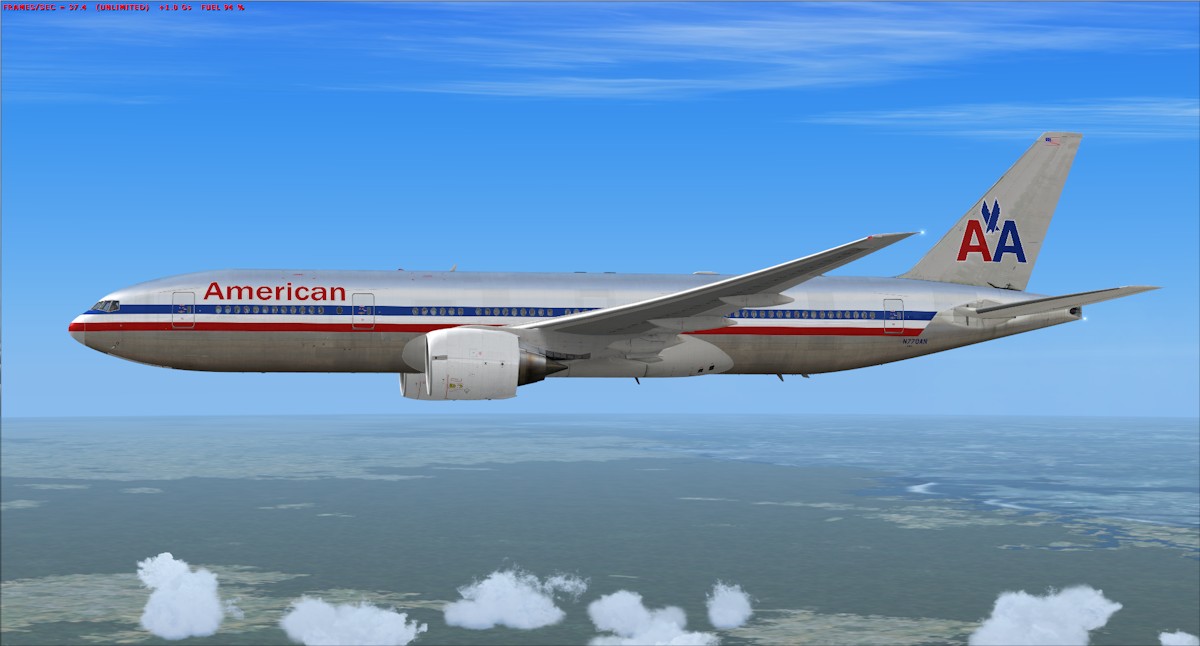 Boeing 777-200ER GE |
 Boeing 777-200ER RR |
With the external model of the Triple 7, Captain Sim has once again confirmed that they are one of the top players in the field of flight simulator add-ons. The exterior models are extremely detailed and the liveries are made of 4X high resolution textures resulting in a plane that looks beautiful in both day and night time.
Compared with photos I found on the web, Captain Sim have captured just about every bulge, antenna, intake and other feature of the real plane. The different engine types are modeled with great accuracy and so is the distinctive form of the fuselage. The different engines are all modeled in detail and the package has enough animations to make even the most discerning flight simmer happy.
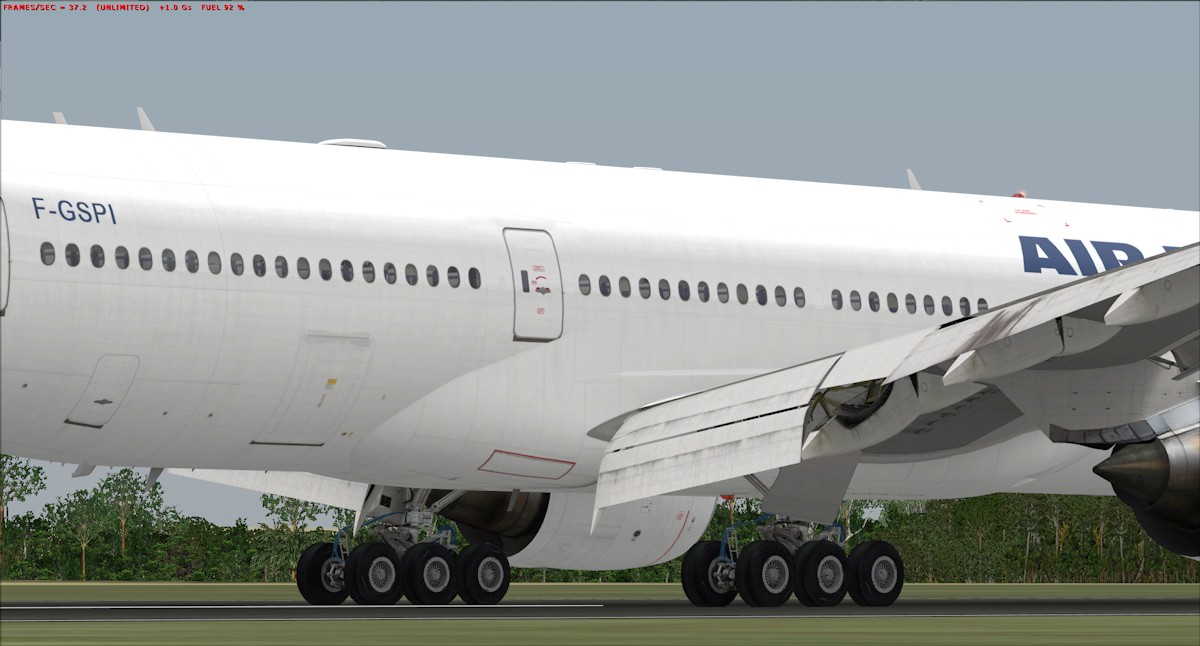 Detail wing flap and main landing gear |
 Detail animations |
 Wing shape and fuselage |
 Very detailed engines |
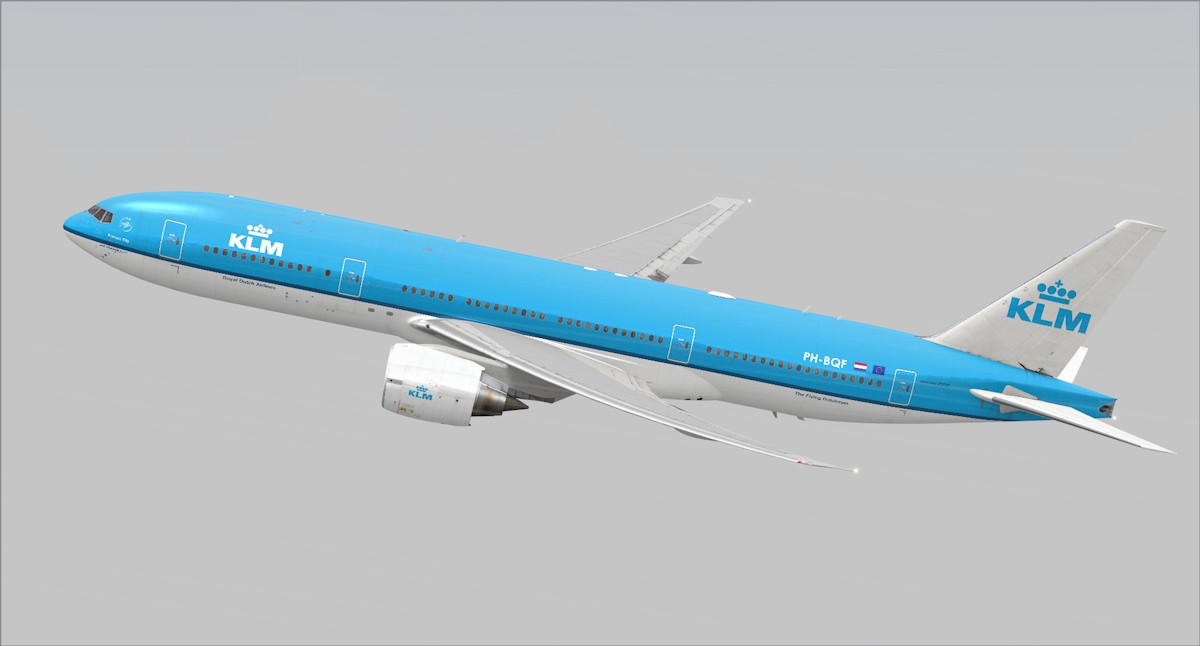 Overall outline is pleasing to the eye |
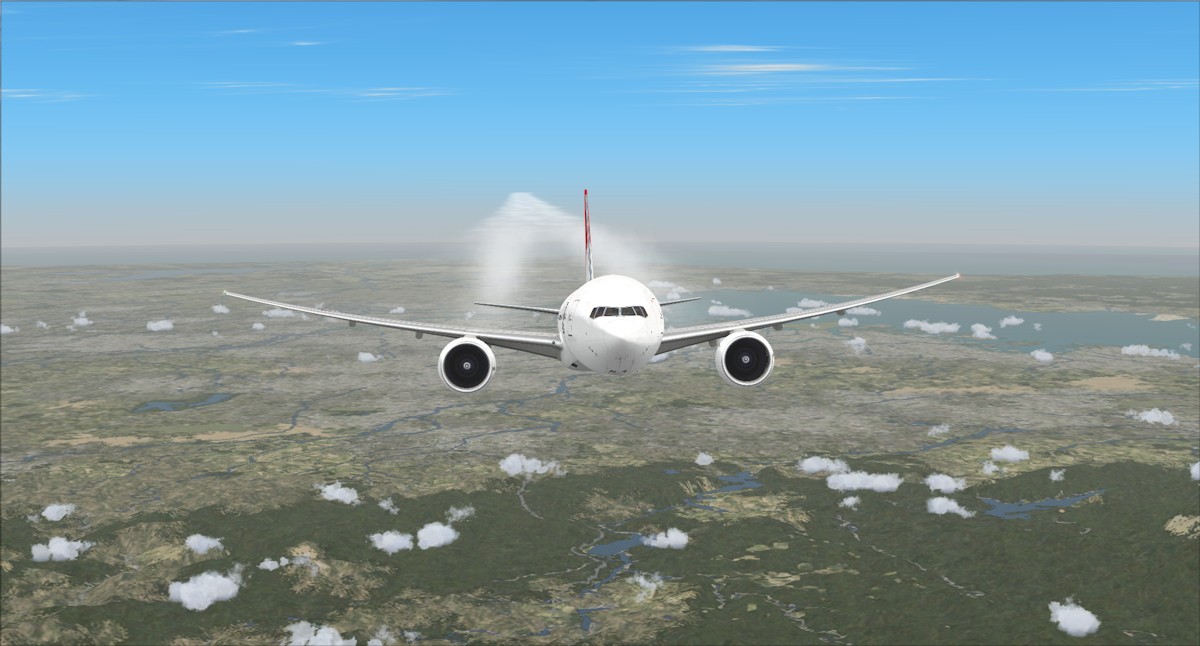 Front view with wing flex |
Internal model
Like the external model the internal model is a beautiful rendition of the real plane. Captain Sim clearly pulled out all the stops and even provided a separate model, consisting of the cabin views.
 First Class cabin |
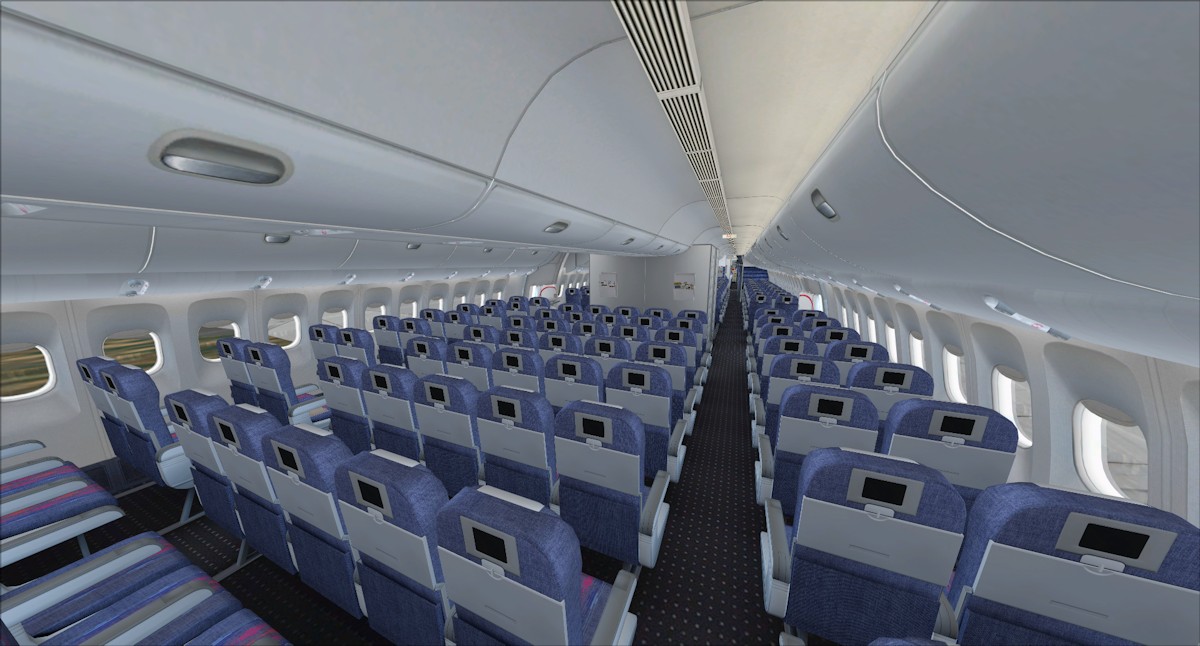 Tourist Class |
But let’s talk about the place where we will spend most of our time: the virtual cockpit.
The virtual cockpit is a faithful representation of the real cockpit and most of the knobs and switches have a function in the simulator. Even the Electronic Flight Bag is a functional item.
The textures are crisp and clear and convey the feeling of ’being there’. There are some little details like a cup of coffee, signs of wear and the markings on the cockpit window that all work together in giving you the feeling you are looking at the real thing. The team at Captain Sim know how to create the feeling of belief.
The night lighting effects of the virtual cockpit are of the same high quality as the daytime textures, but I do have one issue. I was able to switch off the flood light on the overhead panel but I was unable to do the same with the glare shield flood light. The glare shield is thus always brightly lit during the night, unless you switch off all the internal lights. Another small criticism is that I was unable to control the brightness of the lights using the intended knobs.
Since these two relatively minor issues are the only ones I rate the cockpit as very high quality. This is helped by the available options such as the option to hide the yoke, folding arm rests, folding side tables, opening windows, etc. Some of these options are only a gimmick, like the option to adjust the pedals or the option to show the control wheel paper. But they point to an attention to detail that is comforting when you find your way in the cockpit for the first time.
With the use of Shift + F2 a switch panel pops up which you can use to open 2D displays although I never used it during flight – the quality of the VC is more than good enough to be able to live without the 2D displays.
 Panel with GE engines |
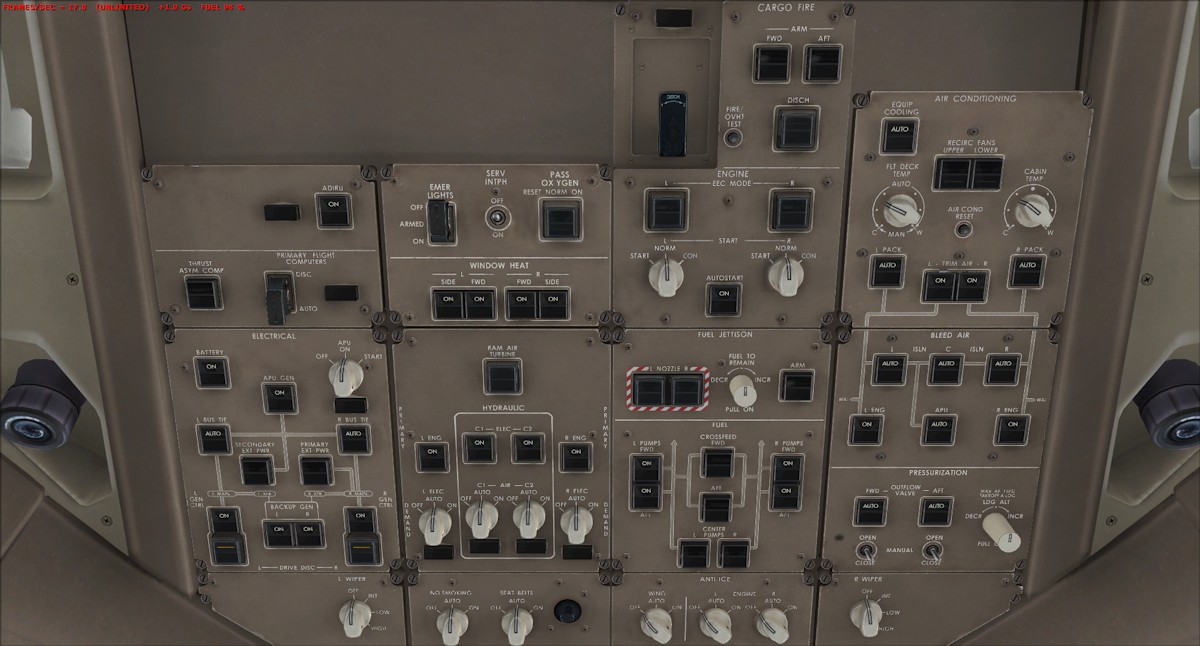 Overhead panel |
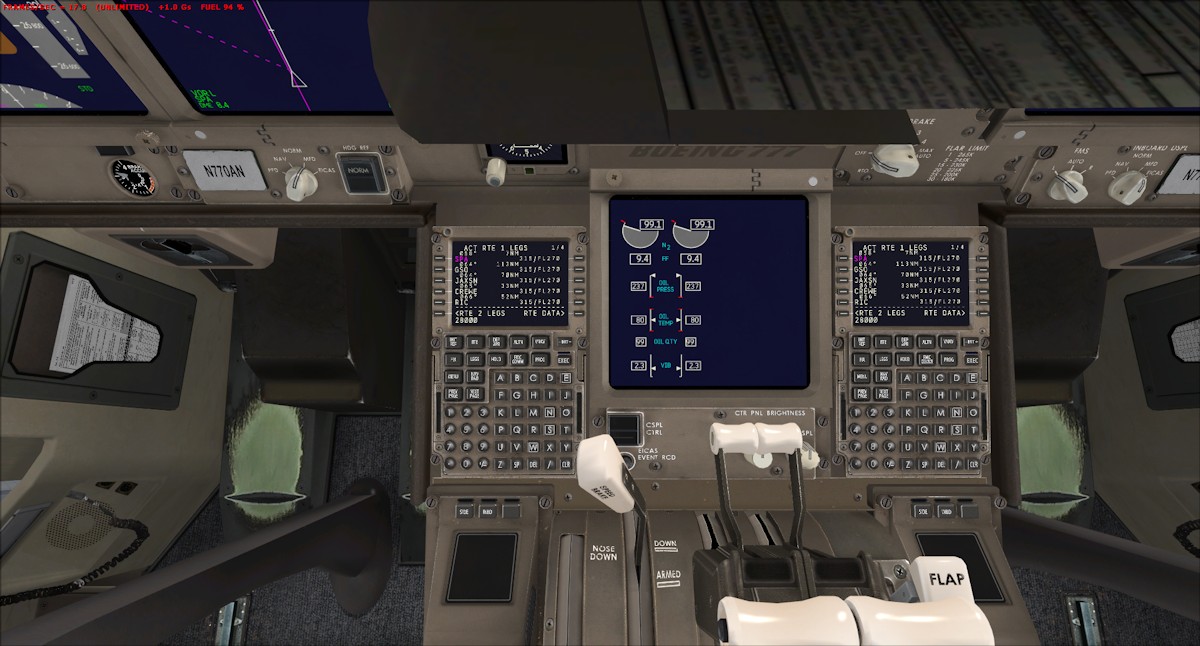 Pedestal |
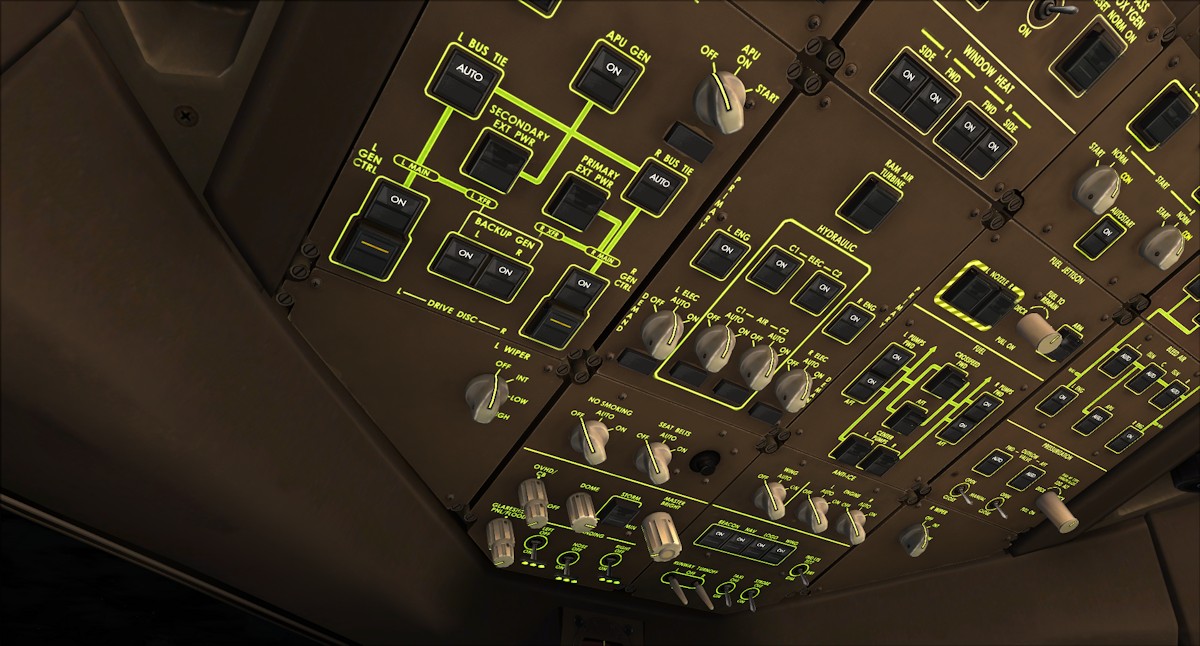 Flood lights |
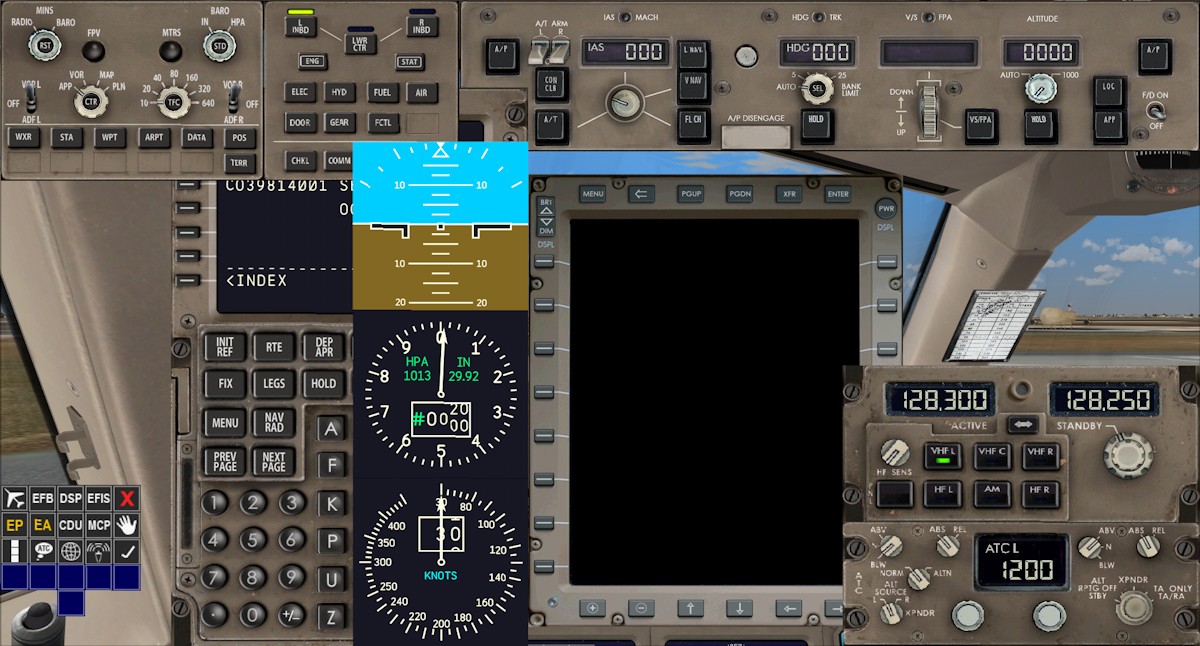 Pop-ups |
 Panel at night |
All this talk about the Virtual cockpit brings me to the next item: systems fidelity.
I see systems fidelity as a part of the internal model and once again the plane scores highly in this respect. The systems are modeled up to a point, but the extent to where they are modeled is such that for normal operations, this is more than enough. The only things missing are extensive fault and error handling and the full functionality of the EFB. If you like to train for emergencies this is a concern. If you just want to fly the Triple 7 with realistic systems it will not affect you a great deal.
The different engines are also modeled in the systems so your Rolls Royce engine displays are different from your GE engine displays.
The EFB is more a gimmick than something very usable, but that is about it.
Sounds
The sounds of this airplane are truly a work of art. They are from the renowned sounds developer TSS and that alone is a virtual guarantee for the quality of the sound set. I can only say you will not be disappointed. From the sounds in the cockpit to the operating of flaps and landing gear to the rumble of the engines, everything is there. And everything is of high quality.
Flight Characteristics
Here is where this review becomes tricky. In some situations I have been unable to assess the behaviour of the plane. In the next section, flight dynamics, it will become clear why that is. But from the behaviour I was able to observe, I would say that the virtual plane performs close to the available figures of Boeing and other reference materials available on the web. Speed, range and to a degree operating altitudes all seem realistic enough.
Flight dynamics
The flight dynamics of the Triple 7 are not good when flying with add-ons like Active Sky or Accu-Feel. These add-ons can make the plane virtually un-flyable at operating altitudes. For me the only way to get good behavior out of the plane was to disable these add-ons. That solved my problem when flying manually. When flying on auto pilot the plane can still get itself in a situation of rapidly worsening yawing as if the yaw dampers are not working at all.
To use this plane with any degree of success I was thus required to shut down my weather program and Accu-Feel. I confirmed this behavior on 2 separate computers with different processors and graphic cards.
When hand flying the Triple 7 version 1.2 it does feel like a big heavy airliner. It can climb fairly rapidly, is a little sluggish on the controls, and those very big engines need some time to react to the commands you give them, just like I expected. Switching on the auto pilot ends the fun in a hurry so in the end I resorted to flying the plane by hand exclusively.
When you do use products like Active Sky or Accu-Feel the plane becomes unstable very easily and at a low altitude. Basically the Triple 7 becomes almost uncontrollable in these situations. As stated earlier these findings were done on two computers to make sure that it was not an issue with the hardware or configuration.
All in all the plane feels realistic when flown by hand without external programs (like Accu-Feel or Active Sky) running. Flying on auto pilot is a recipe for disaster.
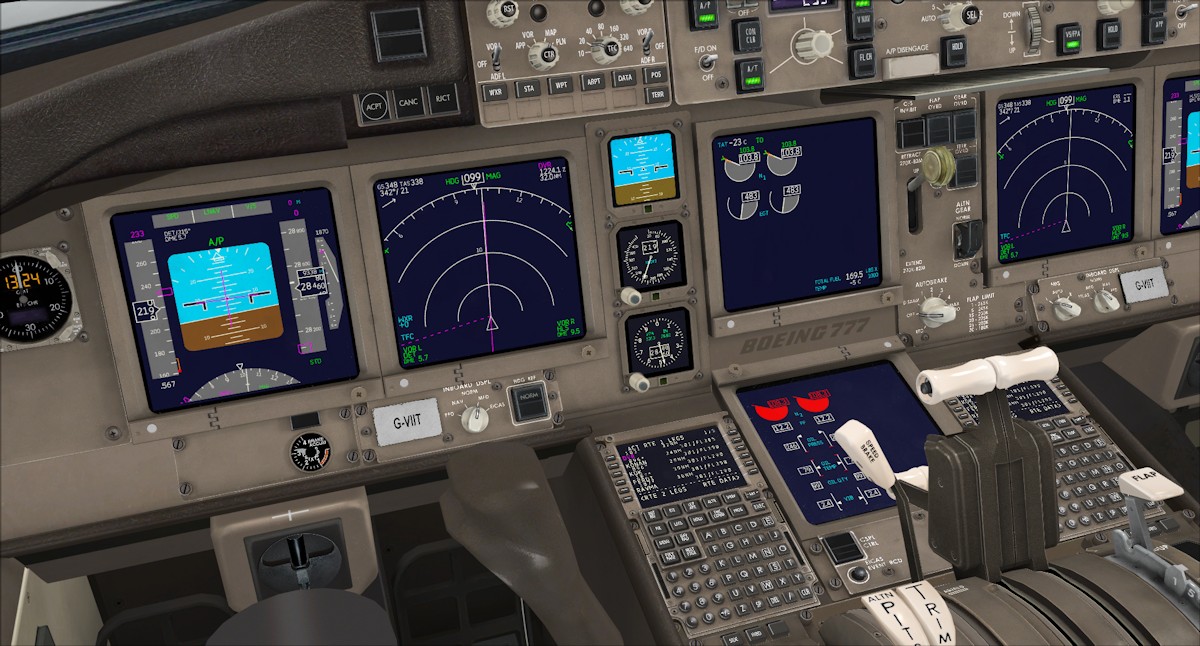 Stressing the engines |
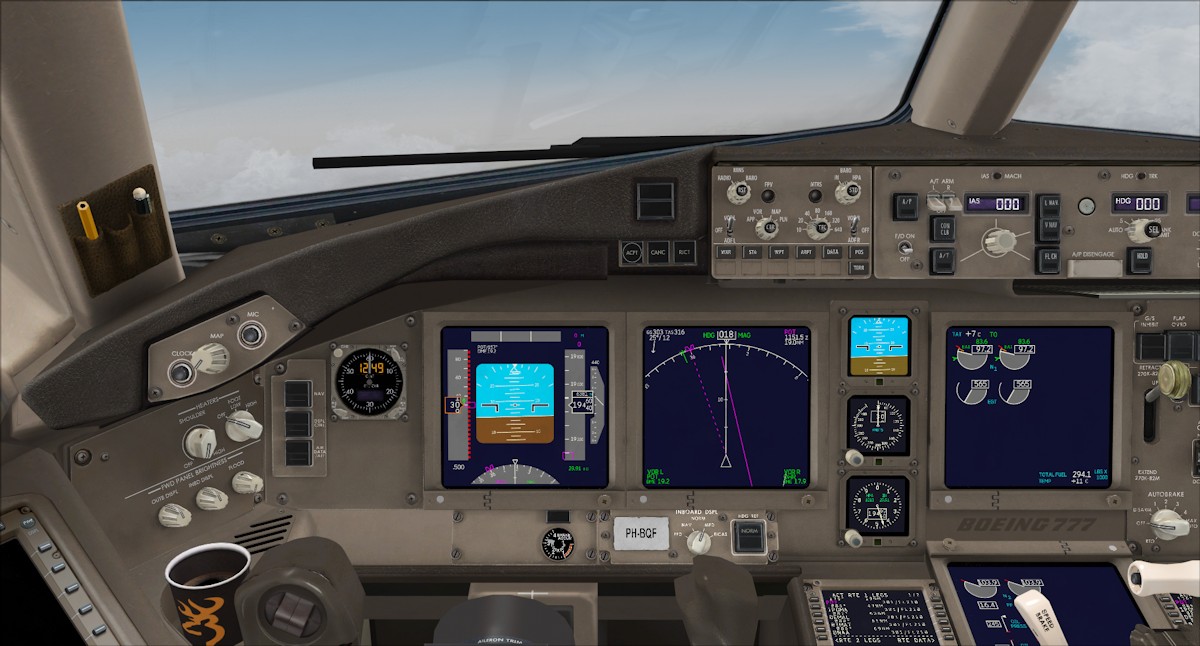 Pitot tubes freezing? |
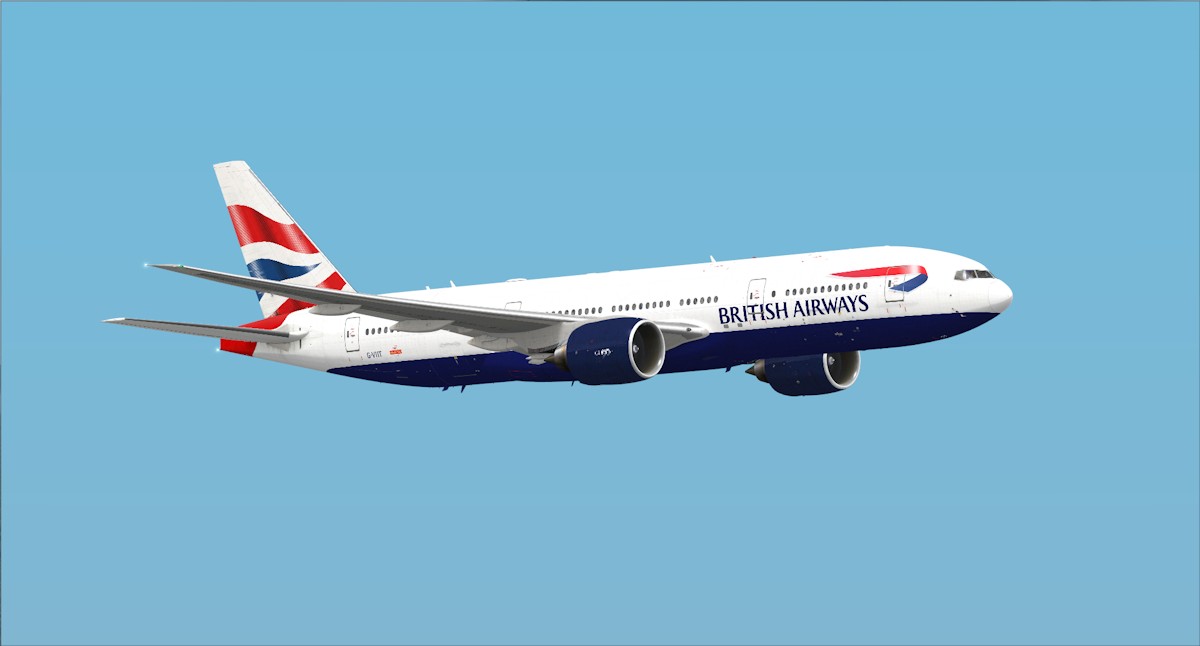 The plane behaves most of the time when hand flying |
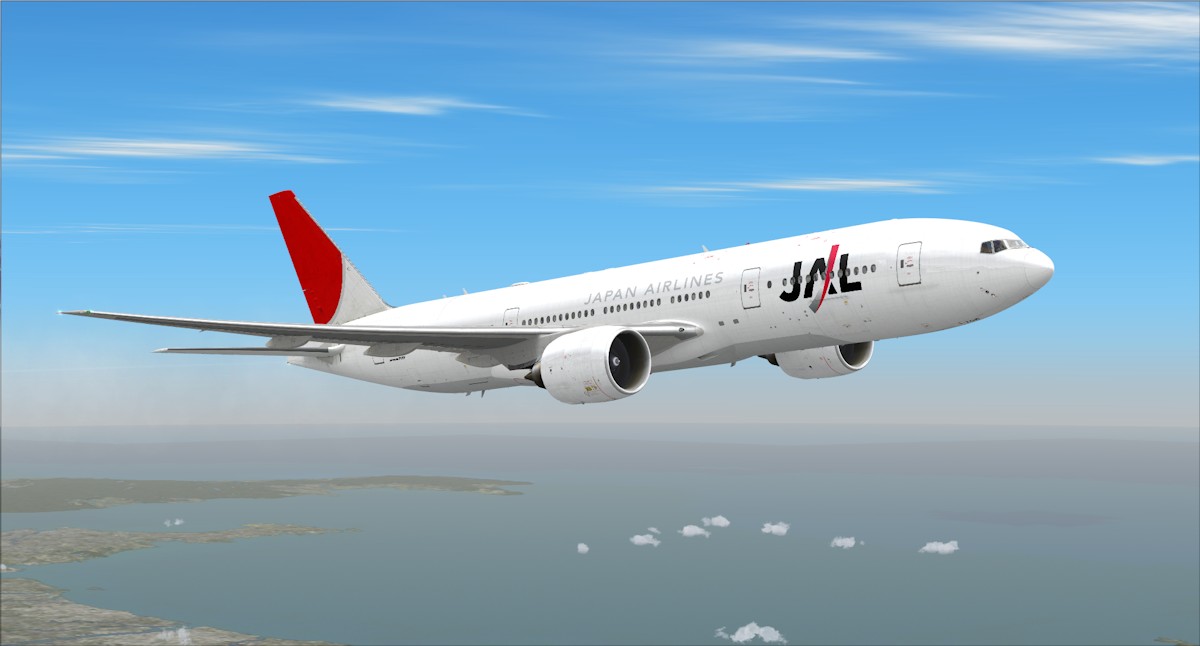 JAL Flight |
Documentation
The available documentation is of good quality, without standing out of the crowd. There is a serious issue however: not all manuals are available. At the time of writing only the User’s Manual and the Aircraft and Systems Manual are available. The Normal procedures and Flight Management System Manual are still missing. Especially the FMS Manual is sorely missed when you are not familiar with Boeings FMS. A training flight is sorely missed – especially now not all manuals are available.
Value for money
Without the issues with the auto-pilot and external products I would have no doubt at all to recommend this plane. It does not have all the features of some more expensive products on the market, but it is a beautiful rendition of the Boeing 777. This is helped by the inclusion of the different engine models, the great sound set and the high quality of the internal and external model.
As it stands even though you can’t blame Captain Sim for the plane not working with other products the issues with the auto pilot are so severe that the choice if this plane is worth the price will be a highly personal one.
For me version 1.2 is worth the price since I hardly use the auto pilot anyway, but I can’t recommend it to just anybody without knowing how it will be used.
Pros:
● Very high quality of external and internal modeling
● Very good VC with nice and functional extra’s
● A lot of good animations
● A very good sound set
Cons:
● Issues with the auto-pilot
● Does not play well with other add-ons
● Incomplete documentation
![]()
Verdict
|
• External model: • Internal model: • Sounds: • Flight characteristics: • Flight dynamics: • Documentation: • Value for money: |
9.0/10 9.0/10 9.0/10 6.0/10 5.0/10 6.0/10 6.0/10 |
 |
| Mutley’s Hangar score of 7.1/10, "Recommended" and a Mutley's Hangar Bronze Award. | ||
Kasper Hanselman
Review machine Spec: Intel i5 2.67Ghz
| 6Gb DDR3 Ram |Radeon HD5670|Windows 7 64bit
|
|
